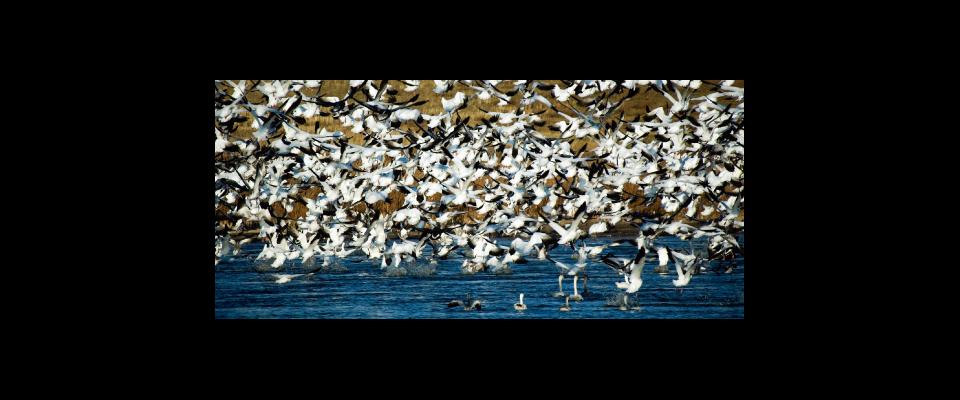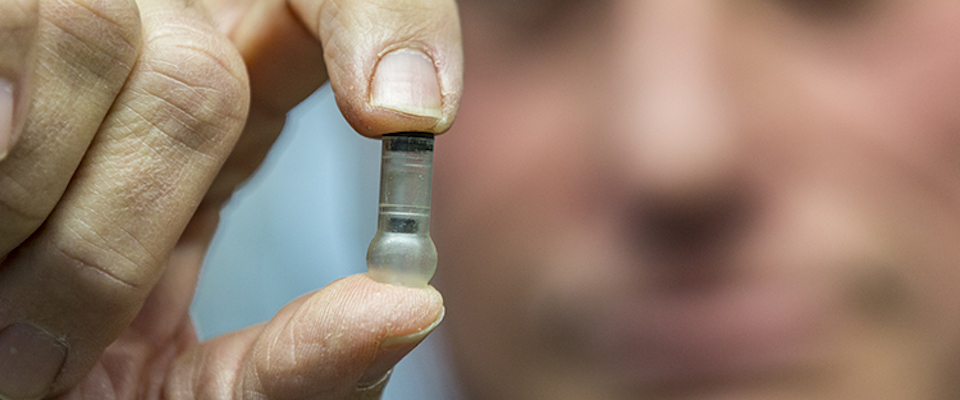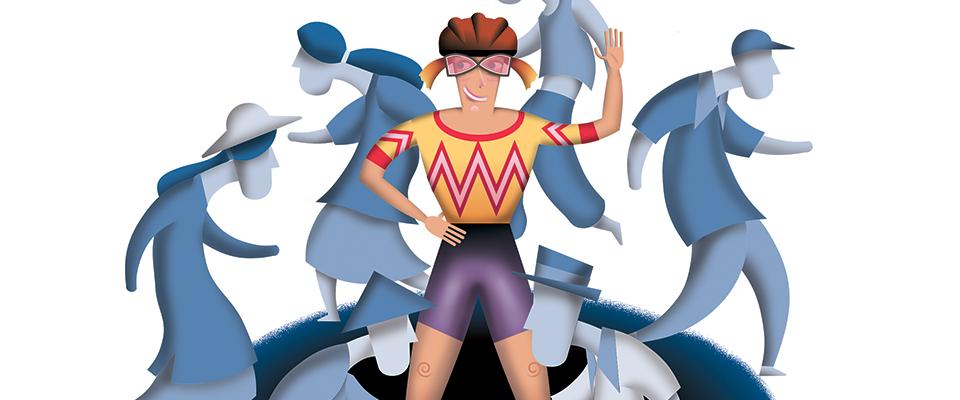A road trip in pursuit of the “Giant honkers.”
I was in a pickup truck somewhere near Custer, Montana, and unlike Hunter S. Thompson, utterly drug-free when I began to hallucinate. It was night, we had been driving for 24 hours give or take, it was my turn at the wheel, and I was seeing and hearing things that weren’t there. Not Thompson’s famed dive-bombing vampire bats, but black, shambling beasts at the side of the road. Imps gibbering in my ear. The roar of an F-15 blowing by our truck.
I pulled over and shook my friend, David Steiner, awake. His face had a wan and bilious cast in the dashboard lights, like he was recovering from chemotherapy. We switched places and I passed out. When I awoke it was dawn, we were in North Dakota, and Steiner was swerving around a road-killed coyote.
Maybe an inauspicious start to a trip, but this wasn’t a mere trip: It was a mission. And from that perspective, we felt that our exhaustion was worth it, the hazard to fellow drivers notwithstanding. We had come to the Big Open, to Saskatchewan, to hunt waterfowl, and for a simple reason: At this time of year—September—that’s where they were.
Saskatchewan lies in the middle of North America’s Central Flyway, and millions of migrating ducks and geese move through the province in the early fall, gorging on the grain and legumes left on recently harvested fields.
We had promised ourselves this trip for several years. An attempt to fly to the province the year before had turned into a fiasco, with flight delays and an inept guide confounding an already truncated schedule. We barely had time to fly in and out, let alone enjoy the countryside and hunt.
The time for this trip, too, was compressed—we had only eight days. But we figured we could drive straight through from California, hunt for three days, and drive straight back. We had made arrangements with a highly recommended guide. He wouldn’t call birds or direct shots for us, just scout waterfowl concentrations, dump us off with decoys, and leave. We’d arrange the decoy spreads and do our own calling, activities well within our competence.
We crossed the border the next day near Noonan, North Dakota, not far from the placid and brown Souris River. Ours was the only car at the crossing, and a strong north wind buffeted us as we exited the cab with our papers. A 30-ish border agent inspected our passports, checked our shotguns, and wished us good hunting. He seemed to me distinctly Canadian, and not just because he said “aboot” and “kaiyoot” instead of “about” and “coyote.” He projected a certain reserve and quiet humor. Also, though he was polite and accommodating, there was an implacability about him, the kind of toughness that results from huddling out on the prairie through winters that last half the year, with little for diversion beyond snowmobiles, beer, and Canadian public TV.
We drove on, heading for the small town of Carlyle, where we expected to meet up with our guide. This portion of Canada’s northern plains is rolling rather than flat; topographic relief is provided by low hills and coulees carved by the last glaciations. Copses of birch and aspen, their leaves turning at this time of year, covered the summits of the hills. Cottonwoods clustered along the creeks. The light, in a sky that was an inverted pale-blue bowl, was palpably northern—thin and lemon-yellow and charged with a peculiar radiance. To the northeast, we saw our first geese: a long, quavering skein of Giant honkers, largest of the seven subspecies of the ubiquitous Canada goose.
Through the truck’s open windows, the air tasted distinctly herbaceous, with a not completely unpleasant whiff of hydrocarbons from an occasional oil- or gas-drilling rig. This was a wild place, in the sense that it was remote, largely empty of people, and replete with wildlife; but it was not a wilderness. It was farmed, and petroleum and natural gas were extracted. It was a working landscape. But the human presence seemed tentative, as though the prairie could surge over the farms and tiny towns at any time. Far more abundant than any inhabited farmhouses and functioning oil rigs were abandoned homesteads, their crumbling gray buildings slowly returning to the soil.
Carlyle looked almost like a movie set: a short, seemingly uninhabited single street lined with small businesses and framed on either end by the vast prairie. Our motel was grubby—highly appropriate accommodations for duck hunters, who usually lodge with muddy dogs and muddier waders. Our guide showed up as we were checking in. A short, slightly stooped, wiry man with a weather-eroded face, he was dressed in ocher coveralls and appeared fatigued. His junior partner was younger, much taller, and sported dark glasses and a wedge-shaped blond coiffure that made him look vaguely like a sphinx.
“Yep, we been scoutin’ all day and found a good spot for you guys where the honkers are really workin’,” our guide said, with an accent straight out of the film Fargo. “We’ll drop you off in the morning with the decoys, and then we’re gonna take off and guide this other group—bunch of bankers from Chicago.”
I asked if there was anyplace nearby where we could do a little freelance hunting that afternoon.
“Oh, sure—Moose Mountain Provincial Park, just up the road there. It’s full of ponds in deep timber, and lots of ducks up there. I bet you guys get some shootin’.”
Moose Mountain was indeed nearby, and it was a lovely ecological anomaly: a huge upland prow rising from the prairie, blanketed with birch and aspen. It supported a small resort hamlet that was shuttered at this time of year—in fact, the entire 99,000-acre park appeared deserted. It felt odd to be hunting in the Canadian equivalent of a state park, but there seemed to be fewer rules of all kinds here, north of the border.
Driving the back roads, we stopped by a small pond. Ducks took flight as we broke through the brush to the water’s edge. We threw out a few decoys and settled against some saplings. Soon we heard the whistle of wings: a pair of gadwalls, a species without quite as much cachet as mallards or pintails, but highly respectable ducks by any measure. Steiner essayed a hen chuckle on his call, and I played antiphony with a couple of single drake quacks. The birds buzzed the pond, and we shot them on the second circuit. We took three more gadwalls before dusk forced us back to the car, happy with a bag of birds, our lunch for the next day.
On the way back to the motel, something that looked like a black Volkswagen on stilts vectored out of the woods and almost collided with our truck. It was the park’s eponym, a cow moose. With her calf in tow, she turned a bulging white eye to us, then disappeared into the night, like a whale sinking into a dark sea.
It is a painful fact that waterfowl hunting entails rising extremely early in the morning. I always feel like someone is shoving a stiletto into my chest when the alarm goes off in my ear at 3:30 a.m., and the morning of our first Saskatchewan goose hunt was no exception. But my mood was up by the time we’d set out our Canada goose decoys and were lying in the portable “layout” blinds provided by the guide—coffins of camouflage-patterned canvas that blended uncannily with the grassy stubble all around us.
As the sky lightened, we saw that we were in a swale between two ranges of hills. Our guide had said we might get some early duck-shooting, before the geese started to work, and he was right. Groups of mallards buzzed our position in the gray light, and we shot several.
We heard a muted gabbling, and then we saw them—hundreds of Giant honkers in ragged ranks across the northern sky, bearing down on us at speed. We barely had time to jack the duck loads out of our shotguns and replace them with ultraheavy goose loads. It was all over in a short time, and we had our limits: eight honkers each, some weighing more than 12 pounds. When the guide returned, we were picking up decoys. He looked at the birds and stopped short, his jaw literally agape: “Whoa! You boys did OK!”
We returned to the motel, and the guide took our birds off to be cleaned. It was time to eat. We breasted out the gadwalls from the previous day’s hunt, set up our Coleman stove on the truck’s tailgate, and began frying up duck meat—the foundation for our lunchtime sandwiches. A couple of guys moseyed up; the Chicago bankers, it turned out. They seem puzzled by our activity.
“So, you guys eat those ducks?”
“Well—hell, yeah, we eat them,” I responded. “Don’t you?”
“Naw. We just come up here to hunt.”
“So you shoot them but you don’t eat them, then?”
He smirked.
Nor was his attitude rare, we found. There are many ethical hunters, but it seemed that a disproportionate number of unethical ones were working the Prairie provinces. We encountered another group, Minnesotans who had been in Saskatchewan for a couple of weeks, touring in a gigantic, heavily customized SUV. It became obvious after a few minutes of conversation that they weren’t eating their birds—merely killing and discarding them. I was enraged, but Steiner reminded me it is unwise to get into a dispute with armed hunters.
That night we had some drinks in a local bar. Among the clientele were roughnecks off the local oil and gas rigs. They were big, muscular guys, many with impressive scars. They smoked like fiends and drank with stolid determination, which made us a bit nervous. But if they were roughnecks, they were also Canadians—polite, restrained in their responses, and wry humored. Unlike many of their counterparts I’d encountered in the United States, they were not looking for a fight.
The next two days were idyllic. We had another goose hunt. And though we didn’t repeat the success of our first shoot, we got a few lesser Canada and snow geese. The high point of the morning was the sight of tens of thousands of snow geese lifting from their evening roost, their white plumage stained pink by the rising sun. In the long, golden afternoons, we hunted Hungarian partridge and sharp-tailed grouse around abandoned homesteads.
We had some more drinks at the bar the last evening and then ate what was literally the worst meal of our lives—vegetables boiled into gray gruel, a frightening meatloaf swimming in viscous gravy. But the food was served in the home of our guide’s mother, an utterly charming woman who described herself as a “simple Canadian farmwife.” We did feel guilty over being repulsed by her cooking.
And in the end we repeated our drive, this time heading southwest, with our ice chests full of geese and ducks. I ate succulent birds all through the winter, and whenever I did I thought of Saskatchewan and its rough, isolate beauty. It made me long for something I can’t quite describe, except that sadness and joy and loneliness are all a part of it.




















